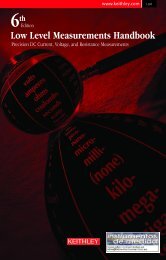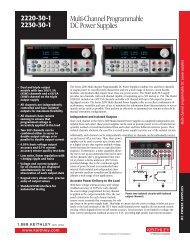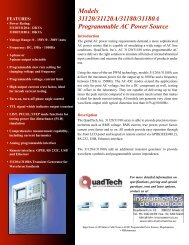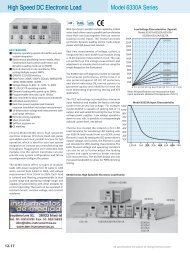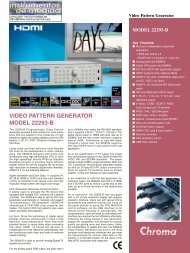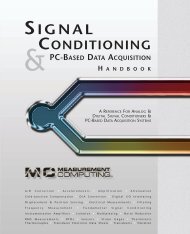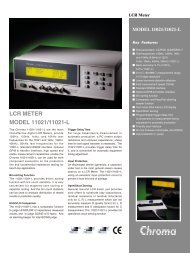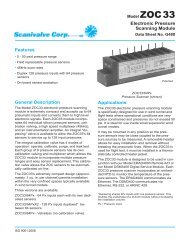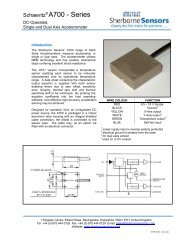Create successful ePaper yourself
Turn your PDF publications into a flip-book with our unique Google optimized e-Paper software.
A7-MXTechnical DescriptionThe principle behind the A7-MX is to inc<strong>re</strong>ase the <strong>re</strong>solution of a digital phasemeter. This is achieved by multiplying the f<strong>re</strong>quency to be measu<strong>re</strong>d to a higher f<strong>re</strong>quency,and then mixing it down to a lower f<strong>re</strong>quency using a local oscillator derived from thef<strong>re</strong>quency <strong>re</strong>fe<strong>re</strong>nce. The principle is illustrated in Figu<strong>re</strong> 1, and has been made the basisof a number of instruments in the past. The <strong>re</strong>lationship is shown for signals down themix/multiply chain for an input signal with a diffe<strong>re</strong>nce of delta f from the <strong>re</strong>fe<strong>re</strong>nce, andalso for a signal with no f<strong>re</strong>quency diffe<strong>re</strong>nce, but with a phase diffe<strong>re</strong>nce of delta t. (Animportant clarification is that “phase” diffe<strong>re</strong>nce beteween two signals can either bemeasu<strong>re</strong>d either in time units or angle units. A measu<strong>re</strong>ment in time units does not specifyor imply the f<strong>re</strong>quency of the signals. A measu<strong>re</strong>ment in angle units (radians) needs a priorknowledge of the f<strong>re</strong>quency. Throughout this description, phase will be measu<strong>re</strong>d in timeunits) It should be noted that a f<strong>re</strong>quency multiplication multiplies a f<strong>re</strong>quency diffe<strong>re</strong>ncebut leaves a phase diffe<strong>re</strong>nce unchanged. Conversely, a mixing process leaves a f<strong>re</strong>quencydiffe<strong>re</strong>nce unchanged, but multiplies a phase diffe<strong>re</strong>nce. When the f<strong>re</strong>quency diffe<strong>re</strong>ncesa<strong>re</strong> converted to fractional f<strong>re</strong>quency diffe<strong>re</strong>nces by dividing by the nominal f<strong>re</strong>quency, itwill be seen that the multiplication factors for f<strong>re</strong>quency and phase a<strong>re</strong> the same.The big disadvantage in the simple approach shown in Figu<strong>re</strong> 1 is that phase drift withtemperatu<strong>re</strong> will be excessive. As rate of phase drift is equal to the fractional f<strong>re</strong>quencydiffe<strong>re</strong>nce, the measu<strong>re</strong>ment of the f<strong>re</strong>quency of an unknown device will be in error. Fo<strong>re</strong>xample, a drift rate of 10ps per second in the first multiplier in the Figu<strong>re</strong> 1 diagram willbe multiplied to 1ns per second at the output. This is equivalent to a 1 x 10 -12 f<strong>re</strong>quencyerror due to drift. Phase drift may occur in mixers and multipliers, but mo<strong>re</strong> especially inmultipliers. If harmonic multipliers a<strong>re</strong> used, drift will occur in the analogue filters thata<strong>re</strong> used to separate the wanted harmonic from the subharmonics and unwanted mixerproducts. If phase lock multipliers a<strong>re</strong> used, phase drift will occur in the digital dividers.To overcome the drift problem, the multiplier/mixer chain is made diffe<strong>re</strong>ntial,ie the <strong>re</strong>fe<strong>re</strong>nce signal is processed in an identical way to the unknown. When the twochannels a<strong>re</strong> subtracted, any drift in the multipliers will cancel. The method of doing thiscan be seen from the functional block diagram of the A7-MX, figu<strong>re</strong> 2. The first stage ofthe processing for both the <strong>re</strong>fe<strong>re</strong>nce and measu<strong>re</strong>ment channels is a multiplication by10 (20 for 5MHz inputs). The multipliers a<strong>re</strong> phase locked loops with a VCXO of 100MHzlocked to the input by dividing by 10 (20 for 5MHz inputs). The phase detectors used a<strong>re</strong>double balanced diode mixer type phase detectors. These exhibit the lowest phase driftwith temperatu<strong>re</strong>. The dividers used a<strong>re</strong> ECL types with very small propagation delays.The outputs of the dividers a<strong>re</strong> <strong>re</strong>clocked using a D type flipflop clocked by the 100MHzVCXO signal. In this way the divider delay is made equal to the propagation delay of oneD type, approx 500ps. As a further <strong>re</strong>finement, the <strong>re</strong>clocking D types for the <strong>re</strong>fe<strong>re</strong>nceand measu<strong>re</strong>ment channels a<strong>re</strong> closely thermally coupled. As the divider propagationdelays a<strong>re</strong> equal to the <strong>re</strong>clocking flipflop delays, the tracking between the <strong>re</strong>fe<strong>re</strong>nce andmeasu<strong>re</strong>ment channels is exceptionally good.The VCXO signals at 100MHz also drive double balanced FET mixers for the first downconversion to 1MHz. The 99MHz LO is common to both the <strong>re</strong>fe<strong>re</strong>nce and measu<strong>re</strong>mentchannels, and is obtained from a 2 way passive inductive type power splitter. The outputfrom the mixers is filte<strong>re</strong>d by diplexer type filters to <strong>re</strong>move the image at 199MHz andthe signal and LO feed through at 100MHz and 99MHz <strong>re</strong>spectively. The wanted IFs at1MHz a<strong>re</strong> passed without further processing to the second multipliers. The avoidance of IFamplifiers at this point avoids drift which could be substantial as the propagation delay ofthe IF amplifier could be several 100 nanoseconds. IF amplifiers a<strong>re</strong> used for the first IF takeoff points to the IF processing board. The first IFs a<strong>re</strong> used when a multiplication of 103 isselected.The second multipliers a<strong>re</strong> nearly identical to the first multipliers with the diffe<strong>re</strong>nce thatthe phase lock loop dividers divide by 100. This multiplies the first IF of 1MHz to the secondVCXO f<strong>re</strong>quency of 100MHz. The second downconvert is identical to the first, with thesecond IFs being passed to the IF processing board.The first and second multipliers/mixers for the <strong>re</strong>fe<strong>re</strong>nce and measu<strong>re</strong>ment channels a<strong>re</strong>built symmetrically on one PCB (Printed Circuit Board). In order to ensu<strong>re</strong> the best possibletemperatu<strong>re</strong> tracking beween the channels, the PCB is in good thermal contact with a thickmetal baseplate. This minimises rapid temperatu<strong>re</strong> changes between the channels.The two pairs of IF signals (sine wave) a<strong>re</strong> passed to the IF processing PCB. The two pairsa<strong>re</strong> the outputs from the first and second downconvertors. They cor<strong>re</strong>spond to finalmultiplication factors of 103 and 105. Also on the IF processing board is the 99MHz LOgeneration and phase lock. A 10MHz unmultiplied signal is passed to the IF processingboard from the <strong>re</strong>fe<strong>re</strong>nce channel on the Multiplier board.The 1MHz IFs could be divided down and measu<strong>re</strong>d di<strong>re</strong>ctly by the f<strong>re</strong>quency counter,which would make a time diffe<strong>re</strong>nce measu<strong>re</strong>ment between the measu<strong>re</strong>ment and<strong>re</strong>fe<strong>re</strong>nce IF signals. In this way the diffe<strong>re</strong>nce between the channels would be measu<strong>re</strong>dand any drift would cancel. Although this would work for a phase measu<strong>re</strong>ment, the<strong>re</strong>would be no way of making a conventional f<strong>re</strong>quency measu<strong>re</strong>ment. The IFs cannot bedi<strong>re</strong>ctly subtracted in a mixer as they a<strong>re</strong> both nominally 1MHz, and the nominal diffe<strong>re</strong>ncef<strong>re</strong>quency would be zero. In order to avoid this problem, the multiplied <strong>re</strong>fe<strong>re</strong>nce IFis f<strong>re</strong>quency shifted to 900kHz using an LO of 100kHz derived from the unmultiplied<strong>re</strong>fe<strong>re</strong>nce. The 900kHz is then mixed with the 1MHz measu<strong>re</strong>ment channel IF to give afinal IF of 100kHz. This final IF contains the multiplied f<strong>re</strong>quency diffe<strong>re</strong>nce, but drift in themultipliers and phase noise in the common 99MHz LO will have been canceled out.The detailed process is as follows:The 10MHz <strong>re</strong>fe<strong>re</strong>nce from the multiplier board (this is derived from the <strong>re</strong>fe<strong>re</strong>nce inputwithout multiplication) is divided by 25 to 400kHz. The 400kHz is then divided by 4 to givetwo quadratu<strong>re</strong> signals at 100kHz. These signals a<strong>re</strong> filte<strong>re</strong>d using low pass filters to give100kHz quadratu<strong>re</strong> sine waves. The 1MHz multiplied <strong>re</strong>fe<strong>re</strong>nce IF (after limiting) is delayedby 250ns to give quadratu<strong>re</strong> squa<strong>re</strong> waves. These operate dual switching mixers with the100kHz quadratu<strong>re</strong> sine waves as the linear inputs. The outputs a<strong>re</strong> combined to form animage <strong>re</strong>ject mixer, with the wanted sideband at 900kHz and the unwanted sideband at1.1MHz. The 900kHz sideband is filte<strong>re</strong>d in an LC bandpass filter to further <strong>re</strong>move theunwanted sideband and the 1MHz feed through. This output is used as the linear input toa further switching mixer which downconverts the 1MHz multiplied measu<strong>re</strong>ment IF (afterlimiting) to the final IF of 100kHz. The final IF is filte<strong>re</strong>d in an LC bandpass filter to <strong>re</strong>movethe unwanted sideband at 1.9MHz and any other mixer products. The measu<strong>re</strong>ment and<strong>re</strong>fe<strong>re</strong>nce channels have now been combined into a single IF of 100kHz with the drift andLO instabilities <strong>re</strong>moved. This IF is now further processed to provide the counter outputs aswill be described in the next paragraphs.The measu<strong>re</strong>ment bandwidth of the system has been defined up to this point by theloop bandwidths of the phase lock multipliers and the bandwidth of the 100kHz LC filter.The 3dB bandwidth is about 8kHz. This means that fourier f<strong>re</strong>quencies further displacedfrom the carrier of g<strong>re</strong>ater than 5kHz will be attenuated. The phase measu<strong>re</strong>ment processessentially samples the phase of the unknown signal <strong>re</strong>lative to the <strong>re</strong>fe<strong>re</strong>nce at a ratedetermined by the selected tau (selectable from 1ms to 2000sec). As with any samplingprocess, aliasing of higher f<strong>re</strong>quency noise into the baseband will occur. Thus further bandlimiting of the 100kHz IF is desirable befo<strong>re</strong> measu<strong>re</strong>ment takes place. The A7-MX has acrystal filter following the LC filter with selectable bandwidths of nominally 10Hz, 60Hz,and 200Hz. For most Allan variance plots at least the 200Hz filter should be used. The useof a filter will <strong>re</strong>duce the noise floor of the instrument which is desirable when measuringvery stable active sources and most passive devices.After the crystal filter the 100kHz IF is limited to a squa<strong>re</strong> wave by a zero crossingdetector. This output is made available to the counter A channel when f<strong>re</strong>quency mode isselected. Both the 100kHz IF containing the multiplied f<strong>re</strong>quency diffe<strong>re</strong>nce informationand the 100kHz unmultiplied <strong>re</strong>fe<strong>re</strong>nce a<strong>re</strong> divided in identical divider chains down to 1kHzto 1mHz in selectable decade steps. The output of the dividers trigger digital (clocked)monostables to generate 10us pulses which a<strong>re</strong> routed to the counter A and B channelswhen phase mode is selected.When the internal digital phase comparator is in use, the phase of both the 100kHz<strong>re</strong>fe<strong>re</strong>nce and the 100kHz multiplied IFs a<strong>re</strong> measu<strong>re</strong>d <strong>re</strong>lative to the unmultiplied 10MHz<strong>re</strong>fe<strong>re</strong>nce. The digital phase comparator then calculates the <strong>re</strong>sulting phase diffe<strong>re</strong>nceor fractional f<strong>re</strong>quency offset depending upon the selected mode. The digital phasemeter also applies averaging if selected. It has internal storage sufficient for 32768measu<strong>re</strong>ments. The RS232 interface to the computer uses full handshaking to p<strong>re</strong>ventdata loss. The internal phase comparator has a <strong>re</strong>solution of 12.5ps, obtained by using ananalogue pulse expander circuit.The meter circuit also uses the 100kHz IF and 100kHz <strong>re</strong>fe<strong>re</strong>nce. The basis of the circuitis a diffe<strong>re</strong>ntial f<strong>re</strong>quency to voltage convertor. However in order to inc<strong>re</strong>ase the <strong>re</strong>solutionof this circuit, a further stage of multiplication and mixing is employed. The 100kHz<strong>re</strong>fe<strong>re</strong>nce is divided down to 500Hz. This f<strong>re</strong>quency is then multiplied to 4.9995MHz usinga phase lock loop with a divider of 9999. The 100kHz measu<strong>re</strong>ment IF is multiplied to5MHz also using a phase lock loop. Finally the 5MHz signal and the 4.9995MHz signal a<strong>re</strong>mixed together to give an IF of 500Hz. An additional fractional f<strong>re</strong>quency multiplicationof 104 <strong>re</strong>sults. On the least sensitive meter range this 500Hz IF varies in f<strong>re</strong>quency from0Hz to 1kHz. The 500Hz measu<strong>re</strong>ment IF and the 500Hz <strong>re</strong>fe<strong>re</strong>nce both trigger digitalmonostables which produce very accurate fixed width pulses . These pulses a<strong>re</strong> used togate an accurate positive and negative cur<strong>re</strong>nt into a chopper stabilised summing amplifier.The output of the summing amplifier is a voltage which drives the moving coil cent<strong>re</strong>zero meter. The meter circuit has four decade ranges which in conjunction with the twomultiplication factors of the main comparator <strong>re</strong>sults in 6 meter ranges with full scaledeflections of 10 -7 to 10 -12 .The meter time constants a<strong>re</strong> linked to the meter range, however may be inc<strong>re</strong>ased ifdesi<strong>re</strong>d using a switch mounted on the <strong>re</strong>ar panel.36Tel +44 (0)1803 862062Fax +44 (0)1803 867962Email sales@quartzlock.comwww.quartzlock.com



